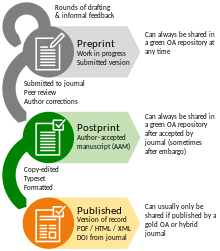

By Thomas Shafee - Own work; adapted from diagram by Ginny Barbour, CC BY 4.0, https://commons.wikimedia.org/w/index.php?curid=87548648
If you want to know your publishers policy on Green Open Access, also known as self-archiving, i.e. uploading to Arrow, you can check using Open Policy Finder

When choosing a CC license, think about why you want to share your work, and how you hope others will use that work.
Try the CC license chooser
It walks you through a decision tree with a series of questions that help you identify the right license for your work.
It also provides a form at the end to create an attribution for the work, as well as Rich Text, HTML, and XMP license formatting for the web.

CC licensed works (outside of the public domain/CC0) must be attributed.
The Attribution builder will help with proper syntax for attribution.
In general, your attribution statement should include TASL:
• Title of the work, if supplied
• Author (legally speaking, referring to the “licensor” (a.k.a., the “copyright holder” or “rightsholder”). This is because, in most CC-licensed works, the licensor is the same person or entity as the author).
• Source of the work
• Text or link to CC license under which the work is shared
• Copyright notice and disclaimer of warranties, if supplied
• Modifications made
Attribution can be made in any reasonable manner based on the medium, means, and context in which you plan to share the work. The TASL elements listed above can be incorporated into the citation style for your discipline.
Example from Recommended Practices (many more examples here):

"Creative Commons 10th Birthday Celebration San Francisco" by Timothy Vollmer is licensed under CC BY 4.0

Authors in Ireland are increasingly being asked to publish their research via Open Access.
These guidelines aim to provide information that will help them to navigate this landscape.
See the guide created by Publish OA Ireland (co-led by the Royal Irish Academy and Trinity College Dublin) on Zenodo here: Guide for Authors
| Green Route | Almost always available – required by policy - upload to Arrow@TUDublin |
| Gold Route | IReL APCs or funded from budgets |
| Hybrid Route | IReL APCs (Open) or subscription (and Green Route via Arrow) |
| Diamond Route | Free for authors and readers – check DOAJ |
Once you create an account on Arrow, you can update your personal details yourself, from your 'My Account' page (top right).
Please note we cannot change any account details on your behalf due to GDPR (General Data Protection Regulation).

From this page, you can select 'Edit Profile':

Once navigated to the 'Edit Profile' page, your first option available is to update your password:

The next section is the 'About' section, under which you can update information about yourself, including your email:

Once you are happy with the changes, click 'Update', if you would like to revert, press 'Reset':

Please note that you can only revise a submission before it is saved to the system. Once you have received a message informing you that you have been published, this option is no longer available to you.
If you need to make changes after an item has been published please contact the manager of the system: arrow.admin@tudublin.ie
To revise a submission:
Materials on ARROW@TU Dublin are made available for educational and scholarly use under Creative Commons licenses. Technological University Dublin endeavours to ensure that it has appropriate rights to provide access to this content.
If you are a rights holder and are concerned that material on ARROW@TU Dublin was added without your permission and believe our inclusion of this material violates your rights, please complete this form.
Upon receipt of a request, the ARROW@TU Dublin administrators will:

These are sometimes applied by publishers to the full texts in institutional repositories like Arrow@TUDublin. Most large publishers require the AAM (author accepted manuscript) [Also known as 'postprint' or 'authors final version'] to be embargoed until publication of the VoR (version of record) or beyond.
Embargo periods vary but are typically 12 months after publication, and can be as high as 3 years.
You can check the publication embargo period for a particular journal using Open Policy Finder. This information may also be found on publishers’ websites.
Yes, even if an embargo is required, you should add the AAM as soon as it is accepted for publication in order to comply with the Open Access policy of TU Dublin.
Embargo period is an optional drop-down selection in the metadata form for any submission.
By uploading to Arrow and including the embargo period, the system will automatically:
The metadata record will be publicly visible on Arrow and will become findable through public search engines such as Google. The full text will appear on the metadata record as a locked file and will not be searchable or downloadable until the embargo period has expired.
There can be other reasons for embargoing a publication in Arrow. Examples include commercial sensitivity, that you are preparing your own press announcement or that the work is subject to a patent.
This work is licensed under CC BY-NC-SA 4.0